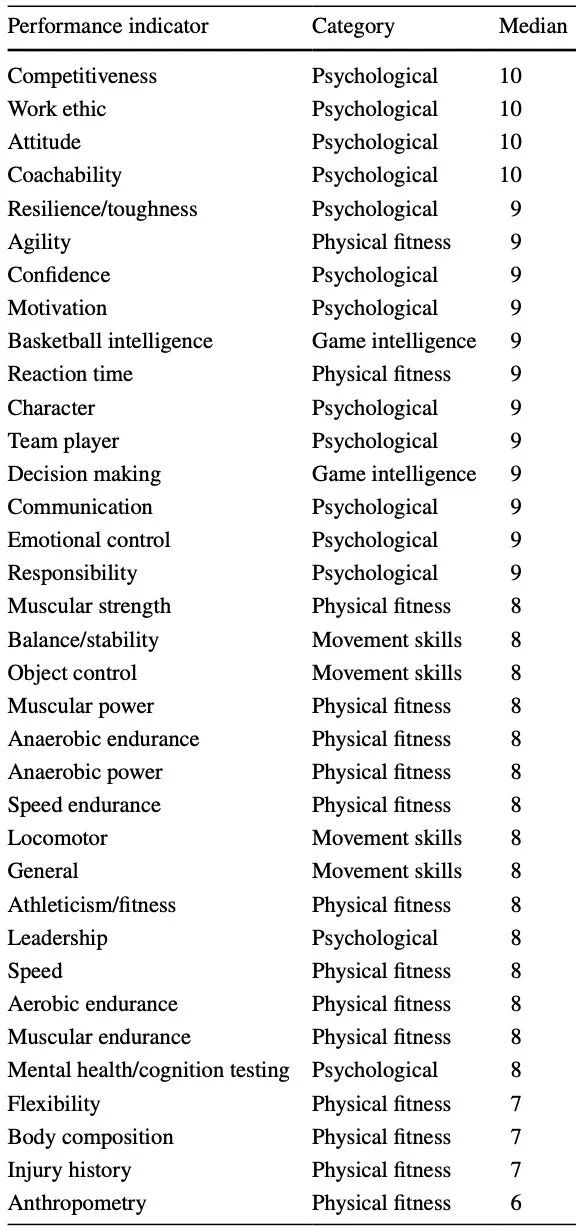What Elite Coaches Look For In Their Recruits
/When my sons played grade school basketball, they would line up across from the other team’s starting five with their coaches rearranging them by height. Our team’s shortest player would be across from his counterpart and so on up the line. The logic, of course, was to match physical size for man to man coverage. And, at that point in their development, that sufficed as a metric for basketball skill.
As they progressed into pre-teen travel teams, coaches realized that the best shooter might be undersized for his age while that surprisingly tall player that had been stuck under the basket was actually the best ball handler. Then, the complications of high school ball, (zone defenses, peer pressure, tender egos and awkward growth spurts), forced coaches and parents to realize that a true team required more than just a vertical jump and sprint speed.
As the old saying goes, “you can’t coach height”, but, according to researchers at the University of South Australia, you can recruit and develop key skills beyond genetic gifts. That was their conclusion after interviewing 90 elite basketball coaches from around the world, including men and women from major college programs and professional teams from the NCAA, NBA, WNBA, and 10 other international leagues.
"Game statistics are commonly used to recruit basketball players but by watching players on the court, and how they behave outside of it, coaches can pick up a lot of non-physical factors that indicate whether a player is likely to make the grade,” said Michael Rogers, a PhD student in the university’s Allied Health and Human Performance program and lead author of the study.
First, they asked the coaches, via an email survey, to name any performance indicator other than raw game statistics (points, assists, steals, etc.) that they use to identify and recruit for their teams. From the overwhelming 608 factors listed, the second round of the study asked the same coaches to rate the options on a 11-point Likert scale, with 0 (no importance) to 10 (extremely important). After compiling the responses, the researchers found 35 indicators with an average rating of at least 6 (important), grouping them into four major categories: physical fitness, psychological, movement skills and game intelligence. The complete list showed the variety of possible ideas:
Physical fitness: Aerobic endurance, agility, anaerobic endurance, anaerobic power, anthropometry, athleticism/ fitness, body composition, flexibility, injury history, mus- cular endurance, muscular strength, muscular power, reaction time, speed, and speed endurance;
Psychological: Attitude, character, coachability, commu- nication, competitiveness, confidence, emotional control, leadership, mental health/cognition, motivation, resil- ience/toughness, responsibility, team player, and work ethic;
Movement skills: Balance/stability, general, locomotor, and object control; and
Game intelligence: Basketball intelligence and decision making.
The abundance of physical variables reflects a longstanding bias towards athleticism when recruiting players. However, after the coaches rated the list, the four indicators that scored a unanimous 10, “extremely important”, were psychological traits; competitiveness, work ethic, attitude and coachability. Of the next twelve indicators, all rated at 9 on the scale, eight were also in the psychological category, along with the two game intelligence factors, basketball intelligence and decision making. Only agility and reaction time (which could be considered more cognitive than physical) from the physical fitness list rated a 9 out of 10. (See the complete list of indicators and their ratings below)
"Coaches look for players who are competitive, have a strong work ethic, are excellent communicators, good teammates and can 'read' the game. Being super fit is a given. It is the other traits that make a difference to the scoreboard,” said Rogers. “Interestingly, the least important indicators were physical fitness and movement skills."
Listen to Rogers summarize the study in this video.
The last round of surveys asked coaches to name the best assessment tool for each of the 35 indicators. While the physical fitness factors each had their time-honored “gold standard” tests, (20m sprint for speed, sit and reach for flexibility, etc.), all of the psychological and game intelligence factors listed only “coach observation” as the best form of analysis.
This led the study team to conclude, “Future research should look to identify acceptable, feasible, and scalable tests for the performance indicators rated by coaches as ‘important’, especially for the psychological and game intelligence indicators, which may benefit from objective measurement. Relationships between objective measures and subjective coach ratings could then be quantified.”
Clearly, from these results, coaches put a great emphasis on the cognitive and psychological skills of players when recruiting for their teams. Fitness and frame size are still important but the intangibles of successful teams seem to be located between the ears.
Daniel Peterson is the co-author of The Playmaker’s Decisions and The Playmaker’s Advantage.
Source:
Rogers, M., Crozier, A.J., Schranz, N.K. et al. Player Profiling and Monitoring in Basketball: A Delphi Study of the Most Important Non-Game Performance Indicators from the Perspective of Elite Athlete Coaches. Sports Med (2021).
https://doi.org/10.1007/s40279-021-01584-w













